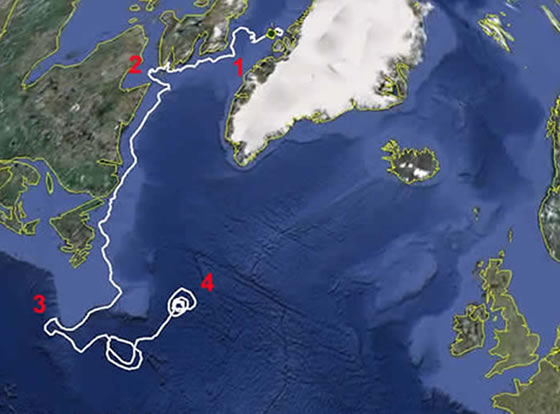Celebrity float 'Bob' (20th July 2011)
Float 05558: Our Argo Marie Celeste continues to send location data
This PROVOR float was originally deployed in October 2008 during the Discovery Bay expedition, as part of the Cape Farewell project. Its hull sports signatures from many aboard the deployment vessel, including Jarvis Cocker and KT Tunstall, and even before its launch it had acquired the somewhat incongruous nickname of 'Bob'! An excerpt charting it's launch is available on the Discovery Bay blog.

Argo float 05558, 'Bob' being signed by Jarvis Cocker prior to launch
From its first profile the float endured challenging conditions; it reached the seabed on every dive and probably encountered sea ice in its later surface phases. It achieved 21 profiles before ceasing transmission in April 2009 and despite sensor problems hinted at some fascinating structures in the water column.

Temperature data from float 05558 before its failure.
However, this was not the end of its story. In July 2010, we began to recieve transmissions again. It had not drifted over this period so had most likely been trapped on the seabed for 15 months!
Due to its mission being officially terminated, 05558 no longer attempts to profile and has become a surface drifter, supplying regular position data for over a year. Although this second phase of its existence no longer generates deep ocean data, its 3500 km journey gives an insight into the surface currents of the North-west Atlantic and is a welcome 'last gasp' from a float that was presumed to have failed.

The path taken by float 05558. Its 3,500 km journey has taken approximately 1 year, although it has been caught in a warm core eddy (4) for 2 months.
Unconstrained by the shelf interactions that normally limit an Argo float in shallow water, 05558 made rapid progress down the coasts of Baffin Island and Canada. Some areas of interest have been highlighted:
- The powerful tides in this region temporarily reverse the southward flow,
resulting in a series of spirals in the float's trajectory. As the dominant
tidal component in this area is the semi-diurnal lunar tide (M2), we know that
each of these spirals took approximately 12 hours to complete. Find out more
about tides and their causes here.

Enlarged section (1) showing the effect of powerful tides on the progress of the float around Baffin Island
- The southward current is interrupted by water flowing in and out of Hudson
Bay. Our float made a precarious transit of the islands at the inlet, coming
close to beaching several times before being carried back out into the Labrador
Sea.

Enlarged section (2) showing the float's progress through the islands bordering Hudson Strait.
- Between (2) and (3) the float makes rapid progress, generally following the line of the shelf and averaging 60 km per day. By (3) the southward current becomes increasingly hemmed in by the Gulf Stream and it is only a matter of time before the float is entrained in the overwhelming eastward flow.
- After a brief spell in a cyclonic (anti-clockwise) eddy the float is entrained in a well-defined anti-cyclonic (clockwise) eddy and here it has remained for the past two months. To find out more about eddies and their importance for physical ocean processes, click here.
We hope that float 05558, 'Bob' will, in time, break free of this eddy and continue its journey eastward. It is possible that 'Bob' will eventually 'return home' and wash up on the shores of the UK, although we have no way of knowing whether it will still be transmitting at this stage.